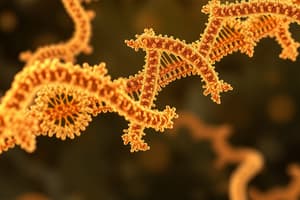Podcast
Questions and Answers
What are the main modifications that occur during eukaryotic mRNA processing?
What are the main modifications that occur during eukaryotic mRNA processing?
Eukaryotic mRNA processing involves capping, splicing of exons, and polyadenylation at the 3' end.
Explain the role of the 5' cap in mRNA processing.
Explain the role of the 5' cap in mRNA processing.
The 5' cap stabilizes the mRNA transcript and promotes efficient translation.
What is the function of the poly-A tail in mRNA?
What is the function of the poly-A tail in mRNA?
The poly-A tail stabilizes the mRNA transcript and facilitates its translation.
What distinguishes prokaryotic mRNA processing from eukaryotic mRNA processing?
What distinguishes prokaryotic mRNA processing from eukaryotic mRNA processing?
Describe the importance of splicing in mRNA processing.
Describe the importance of splicing in mRNA processing.
What role do ribonucleases play in mRNA stability?
What role do ribonucleases play in mRNA stability?
List the order of mRNA processing events.
List the order of mRNA processing events.
Why is mRNA inherently unstable?
Why is mRNA inherently unstable?
What specific methylation occurs in yeast's 5' cap structure?
What specific methylation occurs in yeast's 5' cap structure?
In vertebrates, what additional methylation occurs at the 5' cap beyond cap–1?
In vertebrates, what additional methylation occurs at the 5' cap beyond cap–1?
List two functions of the cap-binding complex in mRNA processing.
List two functions of the cap-binding complex in mRNA processing.
Why is the capping of mRNA crucial for viral RNA recognition?
Why is the capping of mRNA crucial for viral RNA recognition?
What role does the 3' Poly–A-tail play in eukaryotic mRNA termination?
What role does the 3' Poly–A-tail play in eukaryotic mRNA termination?
What mechanism does Rho-dependent termination utilize to remove mRNA from RNA polymerase?
What mechanism does Rho-dependent termination utilize to remove mRNA from RNA polymerase?
In eukaryotes, what happens to mRNA during transcription termination?
In eukaryotes, what happens to mRNA during transcription termination?
How does the Xrn2 exonuclease contribute to the termination process in eukaryotes?
How does the Xrn2 exonuclease contribute to the termination process in eukaryotes?
What roles do CstF and CPSF play during transcription termination?
What roles do CstF and CPSF play during transcription termination?
What is the significance of the poly(A) signal and poly(A) site in DNA?
What is the significance of the poly(A) signal and poly(A) site in DNA?
What effect does the state of the pol II CTD have on transcription termination?
What effect does the state of the pol II CTD have on transcription termination?
Which region does CPSF bind to during the termination process?
Which region does CPSF bind to during the termination process?
What role does PAP (poly-A polymerase) play in mRNA processing?
What role does PAP (poly-A polymerase) play in mRNA processing?
What process gradually decreases the levels of pre-mRNA and mature RNA over time?
What process gradually decreases the levels of pre-mRNA and mature RNA over time?
How does instantaneous inhibition affect pre-mRNA levels?
How does instantaneous inhibition affect pre-mRNA levels?
What is the significance of mRNA stability in eukaryotic cells?
What is the significance of mRNA stability in eukaryotic cells?
Compare the mRNA half-life between E. coli and H. sapiens.
Compare the mRNA half-life between E. coli and H. sapiens.
What role does the 5' cap play in mRNA?
What role does the 5' cap play in mRNA?
When are capping enzymes recruited during mRNA synthesis?
When are capping enzymes recruited during mRNA synthesis?
What modification is made to the inverted guanine during capping?
What modification is made to the inverted guanine during capping?
How does RNA's ribose structure contribute to its instability?
How does RNA's ribose structure contribute to its instability?
Describe the bond formed between the 5' cap and the mRNA.
Describe the bond formed between the 5' cap and the mRNA.
What happens to the two 2' ends of the first two nucleotides during RNA capping?
What happens to the two 2' ends of the first two nucleotides during RNA capping?
What role does poly-A polymerase (PAP) play in polyadenylation?
What role does poly-A polymerase (PAP) play in polyadenylation?
How does the presence of a cap and tail affect the half-life of mRNA?
How does the presence of a cap and tail affect the half-life of mRNA?
Describe how mRNA stability is influenced by its modifications.
Describe how mRNA stability is influenced by its modifications.
What effect does the absence of either a cap or tail have on mRNA translation?
What effect does the absence of either a cap or tail have on mRNA translation?
Explain the interaction between the 5’ cap and the 3’ poly-A tail.
Explain the interaction between the 5’ cap and the 3’ poly-A tail.
What are the consequences of excess caps or tails on mRNA translation?
What are the consequences of excess caps or tails on mRNA translation?
What is the importance of poly-A binding protein (PAB) during polyadenylation?
What is the importance of poly-A binding protein (PAB) during polyadenylation?
How does cleavage of pre-mRNA relate to the addition of the poly-A tail?
How does cleavage of pre-mRNA relate to the addition of the poly-A tail?
Flashcards
mRNA processing in eukaryotes
mRNA processing in eukaryotes
Extensive modifications of pre-mRNA to create a mature mRNA in the nucleus, including capping, splicing, polyadenylation, and export to the cytoplasm.
Pre-mRNA
Pre-mRNA
The initial RNA transcript in eukaryotes, still containing introns and needing modifications before it can be functional.
5' cap and 3' poly-A tail
5' cap and 3' poly-A tail
Structures added to the ends of the mRNA molecule that stabilize the mRNA and enhance translation efficiency.
Splicing
Splicing
Signup and view all the flashcards
5' and 3' UTRs
5' and 3' UTRs
Signup and view all the flashcards
mRNA stability
mRNA stability
Signup and view all the flashcards
mRNA processing order
mRNA processing order
Signup and view all the flashcards
RNA instability
RNA instability
Signup and view all the flashcards
RNA Degradation
RNA Degradation
Signup and view all the flashcards
Transcription Termination
Transcription Termination
Signup and view all the flashcards
mRNA half-life (E. coli)
mRNA half-life (E. coli)
Signup and view all the flashcards
mRNA half-life (S. cerevisiae)
mRNA half-life (S. cerevisiae)
Signup and view all the flashcards
mRNA half-life (H. sapiens)
mRNA half-life (H. sapiens)
Signup and view all the flashcards
5' end capping
5' end capping
Signup and view all the flashcards
Pre-mRNA Capping Time
Pre-mRNA Capping Time
Signup and view all the flashcards
Capping Steps
Capping Steps
Signup and view all the flashcards
mRNA Capping Complexity
mRNA Capping Complexity
Signup and view all the flashcards
Cap-Binding Complex (CBC)
Cap-Binding Complex (CBC)
Signup and view all the flashcards
mRNA 5' Cap Function
mRNA 5' Cap Function
Signup and view all the flashcards
mRNA 3' Polyadenylation
mRNA 3' Polyadenylation
Signup and view all the flashcards
Vertebrate specific mRNA Methylation
Vertebrate specific mRNA Methylation
Signup and view all the flashcards
Polyadenylation
Polyadenylation
Signup and view all the flashcards
Poly-A polymerase (PAP)
Poly-A polymerase (PAP)
Signup and view all the flashcards
Poly-A binding protein (PABP)
Poly-A binding protein (PABP)
Signup and view all the flashcards
mRNA Cap and Tail
mRNA Cap and Tail
Signup and view all the flashcards
Translation Rate
Translation Rate
Signup and view all the flashcards
mRNA Export
mRNA Export
Signup and view all the flashcards
5' Cap
5' Cap
Signup and view all the flashcards
Eukaryotic Transcription Termination
Eukaryotic Transcription Termination
Signup and view all the flashcards
Poly(A) Signal
Poly(A) Signal
Signup and view all the flashcards
CstF
CstF
Signup and view all the flashcards
CPSF
CPSF
Signup and view all the flashcards
AAUAAA (Poly-A signal)
AAUAAA (Poly-A signal)
Signup and view all the flashcards
Torpedo model
Torpedo model
Signup and view all the flashcards
Xrn2 Exonuclease
Xrn2 Exonuclease
Signup and view all the flashcards
Pol II CTD
Pol II CTD
Signup and view all the flashcards
Study Notes
mRNA Processing Part 1
- Prokaryotic mRNA transcription and translation occur concurrently in the nucleoid. This mRNA does not require further processing.
- Eukaryotic mRNA necessitates processing to create a mature transcript.
- Pre-mRNA is transcribed in the nucleus.
- Modifications occur at the 5' and 3' ends.
- Introns are removed, and exons are joined during mRNA splicing.
- mRNA is exported from the nucleus to the cytoplasm.
- Translation regulation involves activating desired messages and suppressing undesired ones (e.g., delayed translation).
- Stability and degradation of mRNA are controlled.
Overview of RNA Processing
- Mature mRNA includes:
- A 5' cap and 5' UTR (untranslated region), which stabilizes the transcript and enhances translation efficiency.
- Start codon, open reading frame (ORF), and stop codon.
- 3' UTR and poly-A tail, increasing transcript stability and enhancing translation efficiency.
- Processing events:
- Capping
- Splicing (during transcription)
- Termination/Polyadenylation
- Splicing (after termination)
mRNA Stability
- RNA structure, especially the ribose sugar's extra hydroxyl group (-OH), makes mRNA inherently unstable and prone to degradation.
- Ribonucleases can target 5' and 3' ends or internal sequences or structures (endonucleases).
- Degradation of RNA occurs for recycling.
- Drugs or heat shock mutations can terminate transcription.
mRNA Half-Life
- E. coli mRNA degrades rapidly (3-5 minutes).
- S. cerevisiae mRNA degrades relatively slower (20-30 minutes).
- Human mRNA degrades comparatively slowly (10+ hours).
- Intact mRNA is more stable, translating into more protein.
- mRNA half-life varies across organisms.
Studying That Suits You
Use AI to generate personalized quizzes and flashcards to suit your learning preferences.




